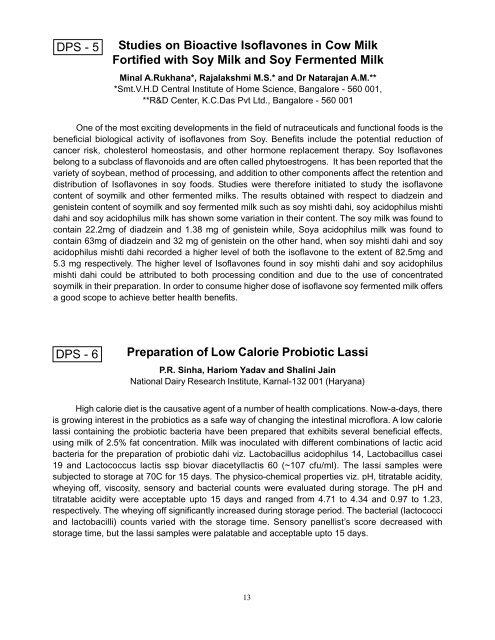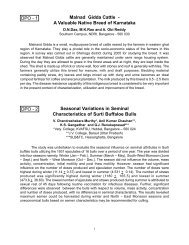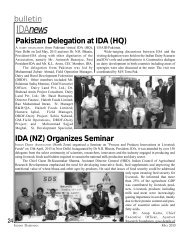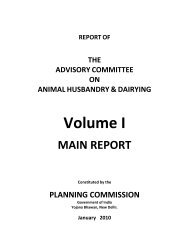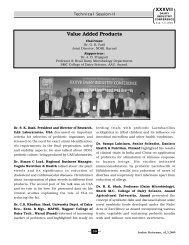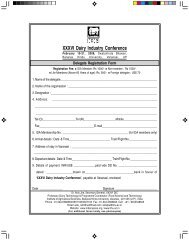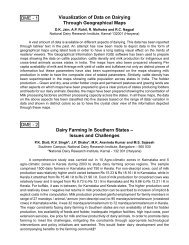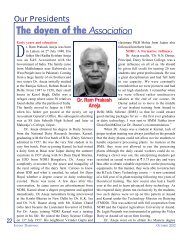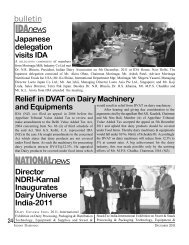Prevalence of Antibiotic Resistance in Dairy Strains of Streptococcus ...
Prevalence of Antibiotic Resistance in Dairy Strains of Streptococcus ...
Prevalence of Antibiotic Resistance in Dairy Strains of Streptococcus ...
Create successful ePaper yourself
Turn your PDF publications into a flip-book with our unique Google optimized e-Paper software.
DPS - 5Studies on Bioactive Is<strong>of</strong>lavones <strong>in</strong> Cow MilkFortified with Soy Milk and Soy Fermented MilkM<strong>in</strong>al A.Rukhana*, Rajalakshmi M.S.* and Dr Natarajan A.M.***Smt.V.H.D Central Institute <strong>of</strong> Home Science, Bangalore - 560 001,**R&D Center, K.C.Das Pvt Ltd., Bangalore - 560 001One <strong>of</strong> the most excit<strong>in</strong>g developments <strong>in</strong> the field <strong>of</strong> nutraceuticals and functional foods is thebeneficial biological activity <strong>of</strong> is<strong>of</strong>lavones from Soy. Benefits <strong>in</strong>clude the potential reduction <strong>of</strong>cancer risk, cholesterol homeostasis, and other hormone replacement therapy. Soy Is<strong>of</strong>lavonesbelong to a subclass <strong>of</strong> flavonoids and are <strong>of</strong>ten called phytoestrogens. It has been reported that thevariety <strong>of</strong> soybean, method <strong>of</strong> process<strong>in</strong>g, and addition to other components affect the retention anddistribution <strong>of</strong> Is<strong>of</strong>lavones <strong>in</strong> soy foods. Studies were therefore <strong>in</strong>itiated to study the is<strong>of</strong>lavonecontent <strong>of</strong> soymilk and other fermented milks. The results obta<strong>in</strong>ed with respect to diadze<strong>in</strong> andgeniste<strong>in</strong> content <strong>of</strong> soymilk and soy fermented milk such as soy mishti dahi, soy acidophilus mishtidahi and soy acidophilus milk has shown some variation <strong>in</strong> their content. The soy milk was found toconta<strong>in</strong> 22.2mg <strong>of</strong> diadze<strong>in</strong> and 1.38 mg <strong>of</strong> geniste<strong>in</strong> while, Soya acidophilus milk was found toconta<strong>in</strong> 63mg <strong>of</strong> diadze<strong>in</strong> and 32 mg <strong>of</strong> geniste<strong>in</strong> on the other hand, when soy mishti dahi and soyacidophilus mishti dahi recorded a higher level <strong>of</strong> both the is<strong>of</strong>lavone to the extent <strong>of</strong> 82.5mg and5.3 mg respectively. The higher level <strong>of</strong> Is<strong>of</strong>lavones found <strong>in</strong> soy mishti dahi and soy acidophilusmishti dahi could be attributed to both process<strong>in</strong>g condition and due to the use <strong>of</strong> concentratedsoymilk <strong>in</strong> their preparation. In order to consume higher dose <strong>of</strong> is<strong>of</strong>lavone soy fermented milk <strong>of</strong>fersa good scope to achieve better health benefits.DPS - 6Preparation <strong>of</strong> Low Calorie Probiotic LassiP.R. S<strong>in</strong>ha, Hariom Yadav and Shal<strong>in</strong>i Ja<strong>in</strong>National <strong>Dairy</strong> Research Institute, Karnal-132 001 (Haryana)High calorie diet is the causative agent <strong>of</strong> a number <strong>of</strong> health complications. Now-a-days, thereis grow<strong>in</strong>g <strong>in</strong>terest <strong>in</strong> the probiotics as a safe way <strong>of</strong> chang<strong>in</strong>g the <strong>in</strong>test<strong>in</strong>al micr<strong>of</strong>lora. A low calorielassi conta<strong>in</strong><strong>in</strong>g the probiotic bacteria have been prepared that exhibits several beneficial effects,us<strong>in</strong>g milk <strong>of</strong> 2.5% fat concentration. Milk was <strong>in</strong>oculated with different comb<strong>in</strong>ations <strong>of</strong> lactic acidbacteria for the preparation <strong>of</strong> probiotic dahi viz. Lactobacillus acidophilus 14, Lactobacillus casei19 and Lactococcus lactis ssp biovar diacetyllactis 60 (~107 cfu/ml). The lassi samples weresubjected to storage at 70C for 15 days. The physico-chemical properties viz. pH, titratable acidity,whey<strong>in</strong>g <strong>of</strong>f, viscosity, sensory and bacterial counts were evaluated dur<strong>in</strong>g storage. The pH andtitratable acidity were acceptable upto 15 days and ranged from 4.71 to 4.34 and 0.97 to 1.23,respectively. The whey<strong>in</strong>g <strong>of</strong>f significantly <strong>in</strong>creased dur<strong>in</strong>g storage period. The bacterial (lactococciand lactobacilli) counts varied with the storage time. Sensory panellist’s score decreased withstorage time, but the lassi samples were palatable and acceptable upto 15 days.13


